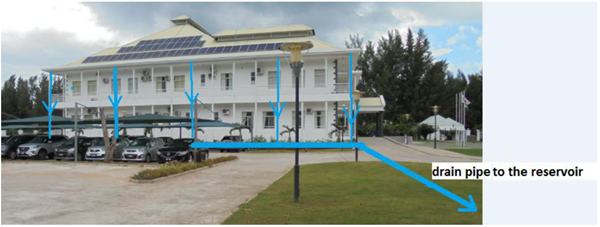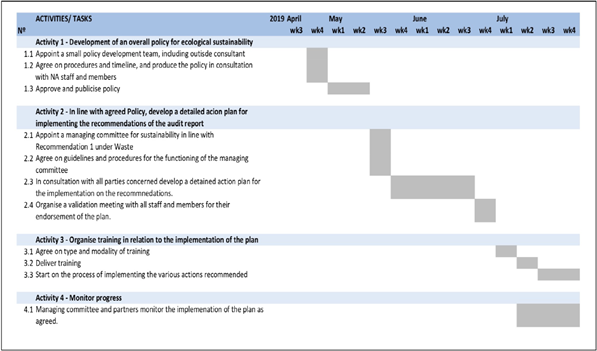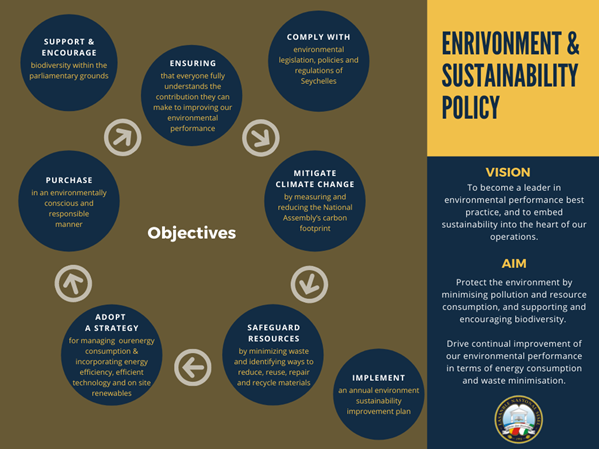
A Parliament for the planet: How the National Assembly of Seychelles transformed its approach to sustainability
Climate hypocrisy is a common criticism levelled at governments and politicians in the media and general public. In fact, according to a study by academics at the University of Manchester, accusations of institutional hypocrisy against governments and politicians are the most frequent type of hypocrisy discourse in the media - beating personal accusations towards celebrities and environmentalists.
It’s important for politicians and political institutions to combat accusations of climate hypocrisy. This should stem first and foremost from a desire to make a personal contribution to the fight against climate change. Behavioural change at an individual level is a key component in the race to “keep 1.5 degrees alive” - to prevent global heating reaching more than 1.5 degrees above pre-industrial levels.
Beyond this, a failure to adopt sustainable practices at a leadership level can undermine crucial public messaging about the importance of sustainable behaviour. Political leaders need to show unity in their commitment to climate action by collectively leading from the front.
As stated in the CPA’s toolkit for Parliamentarians on effective climate action, “promoting environmentally-friendly policies and practices in Parliament can provide the inspiration for others to follow.” To fully convey to their constituents the severity of the climate change threat and the urgency of action, politicians and the institutions they work within must look inward and build a watertight case in favour of transformative climate action.
So, how can Parliaments get their House in order on climate change? This article takes an in-depth look at how one Commonwealth Parliament, the National Assembly of Seychelles, has transformed its approach to sustainability. Read on to find out more about the steps taken by the National Assembly and key takeaways for other Parliaments.
This blog post was developed following a presentation by Hon. Regina Esparon, Member of the National Assembly of Seychelles, at a discussion on gender and climate change hosted by the Commonwealth Women Parliamentarians network.
Assess the issues and collaborate with experts
The transformation process began in 2019, when a local NGO, Sustainability for Seychelles (S4S), received a request from the Seychelles National Assembly to:
- conduct a climate change and environmental sustainability audit of the operations of the National Assembly of Seychelles
- develop an action plan to help the Assembly sustain and improve its environmental climate change performance
A climate change and sustainability audit is a tool that an organisation can use to identify the full extent of its environmental impacts along with best practices for sustainability. The outcomes should help it gain a better understanding of how it can improve its sustainability practices and climate change adaptation performance.

Above: Solar panels installed on the roof of the Seychelles National Assembly in 2019. The system produces about 126,000 kWh per year, which translates into annual savings of approx. £32,500 on the National Assembly’s electricity bill. Image credit: Seychelles Nation
The audit, supported by an EU-funded national climate change project, made the National Assembly the first major public institution in the Seychelles to collaborate with a local NGO on sustainability.
The audit looked at three key areas: energy, water and waste. The process involved gathering technical, quantitative data, for example by installing energy analysers to collect data on daily energy use, and collating qualitative information, through interviews and questionnaires with maintenance and administrative staff.
Takeaways:
Access climate finance. Comprehensive funding is crucial to driving forward transformative projects. There is significant value to be found in exploring donor and partnership options ahead of commencing a project. Several tools are available to help countries unlock available climate finance, such as the Commonwealth Climate Finance Access Hub.
Work with local partners. Collaborating with local organisations helps to build climate resilience with the community, and local knowledge is a powerful tool in the development of adaptation and natural resource management solutions.
Set data-led, user-approved, actionable targets
The audit process produced a series of findings, split into the three areas of energy, water and waste.
Findings included:
- Inefficient fluorescent lighting was in use across the building, rather than energy-efficient LED lights
- Air conditioning contributed to 67% of energy use across the site
- The existing roof structure held significant potential for increased harvesting of rainwater
- Paper usage was very high across the National Assembly
From these findings, the auditors produced a set of recommendations to help the National Assembly reduce its ecological footprint. Importantly, many of these were suggested by staff during interviews and questionnaires.
The targets spanned:
- architectural projects e.g. expanding the rainwater harvesting system
- energy-saving measures e.g. increasing the air conditioning temperature by 3°C - 5°C
- educational campaigns on sustainable practices for staff

Above: The proposed rainwater harvesting system for the Seychelles National Assembly. Image credit: GCAA Seychelles National Assembly Audit Report (2019)
Combined, these measures advocated for a system-wide recalibration of the National Assembly’s sustainability practices, led by an environment-first mindset to operations, rather than piecemeal, disconnected changes implemented at departmental level.
Takeaway:
Secure user-buy in. By involving staff at all levels in the audit, the National Assembly gave agency to its staff to take ownership of the solutions. The result was a set of solutions that emerged organically during the process, rather than abstract recommendations lacking endorsement from the people required to implement them.
Make a prioritised plan of action
The final audit report went beyond simply making recommendations about what the National Assembly should do to improve its sustainability practices. By including a tentative action plan and schedule for reforms, the authors got the ball rolling on the logistical planning required to implement the recommendations. From there, Members and departmental leaders in the National Assembly built out a more detailed plan.

Above: The draft action plan included in the climate change and sustainability audit. Members and staff then worked to add detail and finalise schedules for the action plan based on factors including feasibility, financial implications and staff capacity.
In developing the action plan and determining which targets to prioritise, some factors that had to be considered included:
- feasibility
- financial implications
- timescales
- staff capacity
The outcome of these discussions was three detailed action plans: one each for energy, water and waste. Below are some transferable examples of measures included in the final action plans:
Energy
- Implement a carbon offsetting scheme for travel by Members and staff
- Set up a parliamentary garden to boost on-site biodiversity
- Green purchasing guidelines for all procurement activities
Water:
- Install or expand a rainwater harvesting system
- Water management guidelines
Waste:
- Publish a recycling policy
- Educate all staff on how to recycle
- Reduce printing and encourage an e-Parliament
Takeaways
Map a route to your final destination. Setting ambitious targets will likely be futile if they are not accompanied by a detailed plan of how you intend to reach them. The final action plan should be informed by close collaboration and forward planning by Members and staff. It's important not to lose momentum - finalise and commence the action plan as soon as possible once the audit report has been published.
Prioritise, but don't neglect. Prioritising certain activities will be necessary based on the factors mentioned above but, if the audit process has been thorough and consultative, all the recommendations should be achievable within a identifiable time frame. Ensure your action plan has a clear schedule for all the recommendations, write detailed task lists and identify who will be responsible for taking forward each action.
Implement, monitor and evaluate
To oversee the action plans, the National Assembly established a new Environmental Policy Implementation Committee within the secretariat. The Committee has a specific mandate to monitor and evaluate progress on the action plans, ensuring that the recommendations in the audit report are properly implemented. The Committee is also responsible for reporting annually on progress related to sustainability issues.
Who is on the Environmental Policy Committee?
The Environmental Policy Committee is for secretariat staff and is run on a voluntary basis. At the time of writing, it is chaired by the Deputy Clerk of the National Assembly and the membership is gender-balanced. Members of the Committee act as champions of sustainability within the workplace, educating colleagues on how to lead sustainable lives.
When the Committee was established, the Secretariat also published an Environmental Sustainability Policy. To embed monitoring and evaluation of sustainability across the institution, the policy commits the National Assembly to producing an annual environmental sustainability improvement plan and conducting an annual management review of performance in relation to this plan. In the interest of transparency, the National Assembly will also make performance information publicly available.
Above: The aims and objectives of the Environmental Sustainability Policy in the National Assembly of the Seychelles. Image credit: National Assembly of the Seychelles
Takeaway:
Allocate oversight responsibilities. If it is not clear whose job it is to check in on the progress of a sustainability action plan, or if the responsibility is handed to an individual or team who do not have the capacity to monitor the work, it is easy to lose the impetus to take action. Setting up a specific committee within the secretariat, or giving an existing committee a new mandate, can help drive forward key changes and make individual managers accountable at a departmental level. If you are setting up a Committee, remember to think about diversity within its membership to get a cross-section of views on progress.
Further Reading
- Read the full climate change and environmental sustainability audit and action plan for the Seychelles National Assembly ->
- Find out more about progress on climate change in the Seychelles in an article for The Parliamentarian by Deputy Speaker of the National Assembly of the Seychelles, Hon. Gervais Henrie MNA ->

